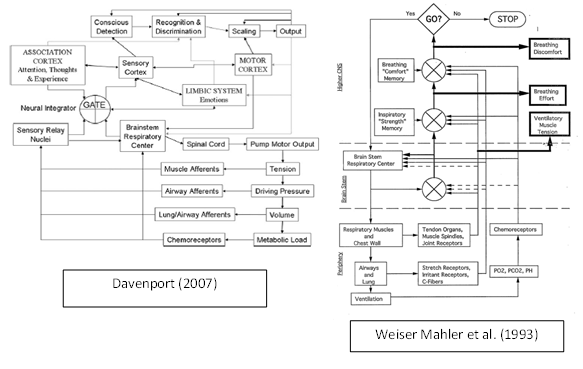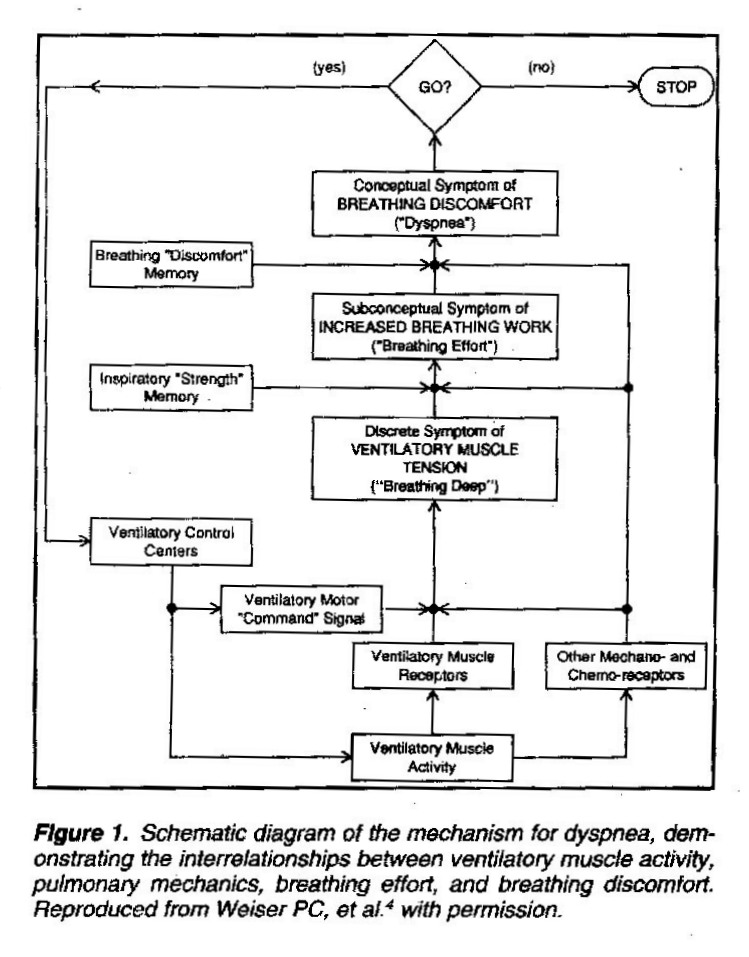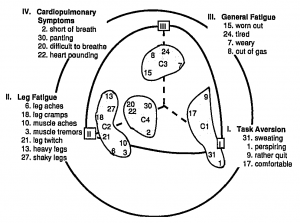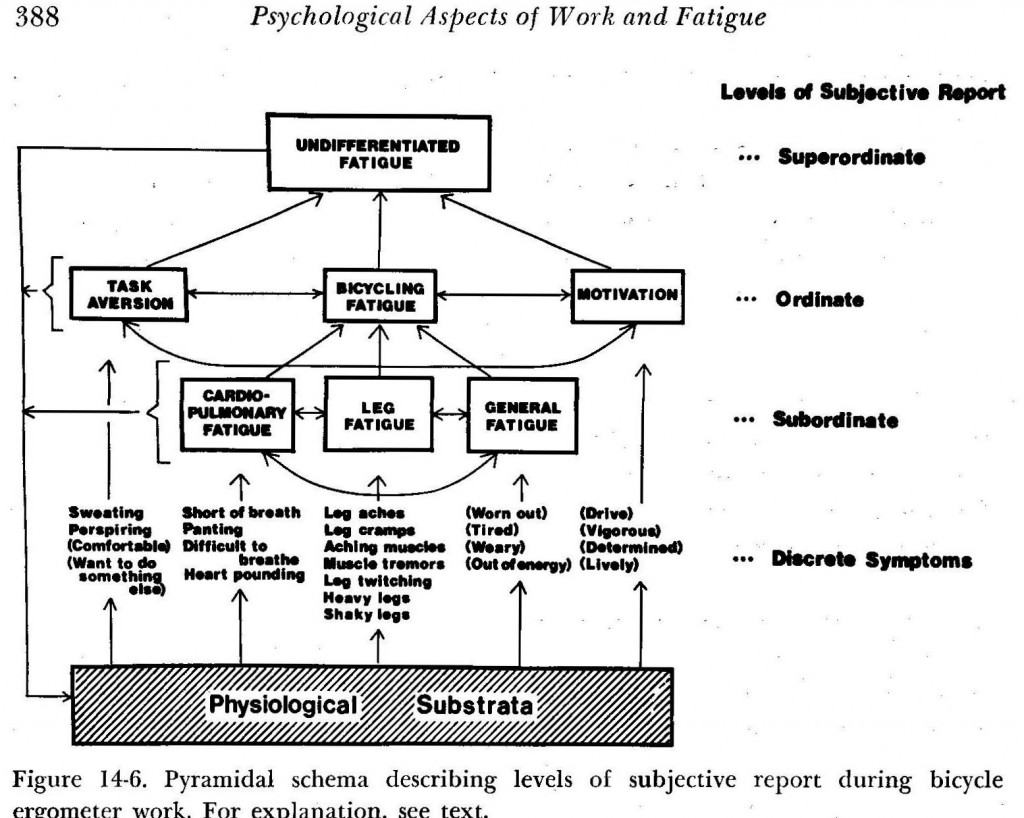Measuring exercise intensity using self-talk or a rating scale helps in achieving an appropriate exercise activity. These aids can help in exercise therapy, wellness promotion, and lifestyle maintenance. Also they can minimize post-exertional malaise. This post discusses how we can use self-talk or The Talk Test and also rating scales to evaluate and produce our own exercise intensity.
Measuring Exercise Intensity using Self-Talk and Rating Scales
March 14th, 2017 by Phil Weiser No comments »Leg Fatigue: Hilly hikes really tire me!
January 26th, 2017 by Phil Weiser 2 comments »Leg fatigue is a key symptom encountered during distance running. And last spring, short hikes used to really tire me out! Overall tiredness and wobbly legs were part of my fatigue when walking or running. How come?
Increasing leg fatigue during exercise indicates that the leg muscles are acquiring task failure. Deconditioning results in more leg fatigue at a given pace. And fatigue occurring for a long time after intense exercise is common for persons with myalgic encephalomyelitis as well as chronic fatigue syndrome (ME/CFS) and with multiple sclerosis (MS). Thus, leg fatigue is an important symptom pointing to some of the limiting factors of distance performance.
How did this leg fatigue happen?
For Endurance Athletes, Is Stretching Counter-Productive?
March 10th, 2015 by Phil Weiser No comments »SUMMARY: “In general, dynamic stretching before you train and static stretching after you train is a great way to warm[-]up and cool[-]down. By taking the time to warm[-]up and stretch before any workout, you’ll minimize the chance of injury.” (Obadike, 2014)
Professor: In addition, here are some myths revealed by questions in a column by Sonya Collins (2014). She wrote,
- “Do any of these lines sound familiar?”
- “You have to hold a stretch [for a long time]to get the benefit.
- “Don’t bounce in the stretch — you’ll tear your muscle.
- “If you don’t stretch before a workout, you’ll hurt yourself.”
- And she replied, “Well, they’re all wrong. But first, there’s a bigger question to answer”
“Do You Need to Stretch at All?”
Student: It sounds like she is really asking, “Is stretching okay?” Or is she questioning, “is stretching counter-productive?”
Click to read more!
What does Pain Salience have to do with Pain Intensity? Part 1
December 18th, 2014 by Phil Weiser No comments »SUMMARY: Part One: There are two separate areas of the insula. One is involved with generalized sensory magnitude integration, and the other is specialized in evaluating nociceptive stimulus properties including a weaker estimation of magnitude.
Student: And what is giving you such a puzzled look?
Professor: I am confused! Some experts have highly criticized one of my favorite research studies.
- In a recent blog post, I wrote about an apparently well designed study by Baliki et al. (2009) demonstrating that the insula was highly involved in dyspnea magnitude estimation (click to see post).
- But even more recently I found a review in which Moayedi & Weissman-Fogel (2009) meticulously critiqued the methods, results, and conclusions of the Baliki et al study.
METHODS AND RESULTS FROM BALIKI ET AL. (2009)
Professor: To be fair to Baliki et al. and Moayedi & Weissman-Fogel, this post will be in two parts, and the parts are detailed. Let’s begin with the design that Baliki et al. actually used in their study:
- Using a finger-span device, the subjects rated thermal pain during an fMRI scan.
- The investigators created lines on slides having lengths identical to each of the subjects’ thermal ratings.
- During a subsequent scan, the subjects rated these lines as they varied in length, i.e., made visual ratings, which unbeknownst to them were the same values as their heat pain ratings.
- To determine how much magnitude variability there was in each participant’s ratings, they
calculated the variance both for their pain ratings and for their visual length ratings.
Student: Please show Part A of their Figure 1 and its original legend from the article by Baliki et al. (2009):
Keep Most of the Body out of the Mind
October 23rd, 2014 by Phil Weiser No comments »SUMMARY: This post explores sensory gating of external and internal sensation. Can our reticular thalamic nuclei keep out or reduce ‘irrelevant’ sensory information for the endurance athlete?
EVIDENCE FOR SENSORY GATING
Student: That summary looks familiar: gating in sensory information and gating out other sensations.
Professor: Yes. (See more at: The Sensory Gate is Real.) First, let’s briefly review the evidence for sensory gating (SG). .
- The ability to do pre-attentive filtering of background sounds (Kisley et al, 2004).
- The loss of filtering ability due to strokes which include the ventral posterior lateral thalamic nuclei (VPL) and results in flooding of sensory gates (Staines et al., 2002).
- The second of paired inspiratory occlusions is reduced (Chan et al., 2008).
- The thalamus has a thin ‘skin,’ the reticular nuclei, whose function is to help focus our attention, allowing only ‘unusual’ activity to pass through gates (Halassa et al., 2014; Ward, 2013).
INDIVIDUAL DIFFERENCES IN SENSITIVITY
Student: Another way of looking at SG evidence is to notice individual differences in sensitivity.
Professor: The evidence does show that some individuals have
- too much sensorimotor sensitivity: anxious persons are very aware of background sounds, and/or
- too little sensorimotor sensitivity: depressed individuals show too little awareness (Paulus & Stein, 2010).
Student: Are there any scales for measuring individual sensorimotor sensitivity?
Excessive fatigue, exertion, and so on are nuisances limiting daily activities
October 1st, 2014 by Phil Weiser No comments »Summary: List blog topics that will help prepare review for a journal about fatigue.
Student: You have been invited to write a review about Fatigue and RPE. Congratulations!
Professor: Thank you, Simone Cairns of Auckland University of Technology, New Zealand for setting up the invitation. The actual invitation came from Fred Friedberg, for his journal: “Fatigue: Biomedicine, Health & Behavior”
And its temporary title is, “How can our perceptions become factors limiting prolonged performance?”
Student: First of all, what do you do this summer?
Professor: Anne and I spent a wonderful week at Lake Dunmore visiting with her Vermont son and his family. Below is an evening photo from the dock with canoe and kayak below the cottage.
Student: Well did you do anything related to exercise science?
Professor: Yes. I did get in some interesting reading about:
- High Intensity Interval Training (HIIT, Ref. 1); my brother, Karl, mentioned this to me. I discovered that this has become my preferred exercise mode since I was about 60 years old, about 12 years ago!
- Fatigue and Fatigability; Enoka (Ref. 2) helped me bridge my conceptual gap that existed between acute and chronic fatigue.
- Talk Test (Ref. 3); hey, I used this with cardiac and pulmonary patients 30+ years ago to avoid talking to themselves in paragraphs and not exercise hard enough.
- Pacing and decision making; a recent review by Smits, Pepping, & Hettinga (Ref. 4) validated my concepts about perception merging into action by using Cizek’s Affordance Competition Hypothesis (e.g., see Sensory Processing Part 2).
Student: And what are your proposed topics for Fall 2014?
Professor: First I suggest we review the following:
- What limits the ‘mix’ of perceptions that one experiences?
- Reticular thalamic sensory gates do not allow passage of ‘unwanted’ info and
- Use of ‘searchlight’ by posterior insula during body scan to change ‘mix.’
- How are the intensities of perceptions estimated and reported?
- Anterior-middle insula estimates the magnitude of the intensity, and
- Internal talk sets up the reporting of symptom intensity.
- How do I
- process my perceptions,
- select my actions from predictions of possible outcomes, and
- report my symptoms?
“It’s getting hard to breathe”: Six Processing Stages from Mismatch to Symptom Report – Last Part
July 9th, 2014 by Phil Weiser 1 comment »Professor: This post will finish the proposed six (6) stages for handling breathing discomfort. So far, we have completed a tour through the first five (5) stages:
1. CONTACT! A breathing alarm signal just arrived at posterior insula!
2. SEND OUT ALERT! Anterior insula and the rest of saliency network (SN) received the alarm, too!
3. FULL ATTENTION! The SN puts the Central Executive Network on the lookout & quiets down the Default Mode Network!
4. GET READY TO ACT! Task: Breathing 'tubes' want medication via inhaler!
5. ACT! Action: Go get inhaler and use it!
Professor: We will add a final, sixth stage for communication to Menon & Uddin’s model of five perceptual processing stages (2010) that has been our guide for the first two parts. (Here are links to Part 1 and to Part 2.)
6. COMMUNICATE! Let others know how well the medication is working!
Professor: This sixth stage includes listening for the meaning of a question and then answering it. For us, the answer will estimate a subjective rating of shortness of breath. For example, “Easy breathing” or “It’s moderately hard to breathe!”
Student: Some people ask me about my breathing. And I really don’t know what to say!
Professor: Asking questions is great tool for opening our ability to connect to our self. Already our mind has shifted its attention and is taking actions. Talking about symptoms, while experiencing them, is in the details for the upcoming Stage 6: Communicate!
“It’s getting hard to breathe”: Six Processing Stages From Mismatch to Symptom Report – Part 2
March 10th, 2014 by Phil Weiser No comments »Professor: This post will continue following someone experiencing a mild pulmonary inspiratory obstruction, like putting on a surgical mask to reduce symptoms of asthma in cold weather. In this post, we will discuss:
- switching attention from being fully alert; to
- planning, selecting, and activating motor responses.
Student: What about:
- consciously detecting and recognizing this event, choosing a verbal description, scaling it, and using the scaled words to report our level of dyspnea.
Professor: Regrets, it’s snow time out here in Pennsylvania, and that discussion will now be in Part 3, the final post of this series.
Student: As a model, we used Figure 5 of Menon & Uddin (2010) with their five stages for processing sensory input and attentional control. The sixth stage we will add about Subjective Report.
Professor: And, what processes were covered during Stages 1 – 3? Click link to read more
“It’s getting hard to breathe”: Six Processing Stages From Mismatch to Symptom Report – Part 1
January 8th, 2014 by Phil Weiser No comments »Summary
Professor: Part 1 of this post is about the beginning of the time course for symptom awareness: Within about .015 seconds, less than one breath, the Saliency Network (SN) of our brain can NOTICE something is strange.
Student: At the end of the third of six stages of relatively fast cortical processing, for example, becoming aware of inspiratory load, we will be sending an alert to the Central Executive Network and dampening the Default Mode Network..
Fast Processing
Student: How quickly do we make critical adjustments before we are ‘done in’?
Professor: These adjustments occur within a breath. In fact, both Gozal et al. (1995) and Raux et al. (2013) compared effects of single versus continuous inspiratory loads.
- WITHIN ONE BREATH, Raux et al. showed:
- increased activity in:
- insula cortex, the hub of interception integration,
- thalamus, the final ‘gate’ to higher centers, and other areas, and
- decreased activity in:
- cingulate cortex,
- temporal-occipital junction, and other areas.
- increased activity in:
Analyzing individual, subcortical, MRI frames was done by Gozal et al. who found:
- AN IMMEDIATE INCREASE in activity of the:
- parabrachial (Vth motor) nucleus, locus coeruleus,
- thalamus, putamen, cerebellum (cumen, central vermis, tuber, & uvula), and other areas
- Post respiratory load recovery followed two time courses:
- immediate decrease, i.e., putamen and cerebellar uvula, or
- slow signal decrease, i.e., basal forebrain and cerebellar vermis.
- Both studies showed decreasing higher CNS activity for continuous load versus single trial of loading, about which Raux et al. suggested this possibibly shows “cortical automatization secondary to motor learning.”
Student: In fact, the charts are very reminiscent of the blog posts you wrote about the adaptation to split-belt walking, especially the involvement of the cerebellum. For examples and discussion, see:
- Control-of-leg-timing-vs-placement-during-split-belt-walking, and
- How-does-the-motor-system-correct-walking-errors?
Professor: Very intriguing recollection of yours about the cerebellum, split-belt walking, and adaptation. Actually, the effect of inspiratory load happens within milliseconds: Click here to read more
Updating Body Sense: Windshield Wiping of Cortex and Using an Insula Searchlight
December 19th, 2013 by Phil Weiser No comments »SUMMARY
Professor: This post is about:
- Q: How do we continuously
- update our ‘body senses’
- while we are exercising (or whatever we are doing)?
- A: We use our brain alpha rhythms,
- like a windshield wiper,
- to disregard ‘unimportant’ neural network activities.
- Q: How are the ‘important’ neural events detected?
- A: We use our
- right anterior insula’s body scanning ‘searchlight’
- to spot unexpected, significant sensations and
allow them into consciousness.
Student: So,
- If we have tonic alertness,
- we can continuously update our ‘body sense’
- using brain alpha oscillations to actively suppress task-irrelevant areas.
- If we are selectively attentive,
- we can rapidly detect critical psychophysiological events, i.e., physiologically evoked potentials,
- by using the Posterior Insula’s Searchlight,
- to sense them trying to get through the Sensory Gates, aka, the thalamic reticular nucleus,
- and allow sensations to enter the pathways to the higher cortical centers.
Professor: Very nice analogy. Yup, and now let’s get into the details. First, our bodies are actively disregarding its ‘normal’ noises. Click link to read more
Symptoms are spotted by Posterior Insula’s Searchlight
November 21st, 2013 by Phil Weiser No comments »Student: Today it was cold outside, and when I started out to exercise I promptly reactivated my cold-induced asthma. I could hardly catch my breath until I put a hand sock, er, ‘glove’, over my mouth and nose. Voila, not so much wheezing, and my breathing became a lot easier.
Professor: Very smart trick, like our study highlighting the simple use of a surgical face mask to block exercise-induced wheezing (Brenner et al., 1980).
Student: Say, in our last blog post you suggested that,
- the thalamic reticular nucleus (TRN) acts like an externally driven searchlight.
Professor: Please, also remember that the TRN acts as a bottleneck allowing only a small part of the thalamus’s activity to travel up into the cortex. Perhaps a better metaphor is a clogged up strainer, and the function of a searchlight is to show holes that ought to be opened.
Student: But what is the mechanism that operates the searchlight? Click here to read more
The Sensory Gate is Real
October 29th, 2013 by Phil Weiser No comments »Student: Where have you been?
Professor: Well, I’ve gotten lost deep in the forest of pulmonary physiology. So, for dyspnea described as ‘breathing too deeply’, let me list the paths I’ve covered:
- Starting along the path from the brainstem respiratory centers ,
- through phrenic spinal cord motoneuron,
- and the contracting diaphragm;
- then traveled from its tendon organs up their afferents,
- passing the C4-C5 dorsal root ganglia to external cuneate nucleus,
- and to ventral posterior lateral thalamic nuclei (VPL),
- that acts as a gate for sensations,
- so that only some can become respiratory perceptions.
Student: Wow, what a sensory gating trip. I’m guessing you could go on talking for hours!
Professor: I sure could, and instead, a short, annotated reference list will do.
1. Ventroposterior thalamus and somatosensory gating
Professor: Evidence #1 for Sensory Gating:
a. Some individuals seem to be flooded more by background sound than others:
Oops I forgot, and I must reconnect to THE BREATH
August 1st, 2013 by Phil Weiser No comments »Student: Today my asthma lots of wheezing, and I was really terrible at meditating, at focusing on my breath.
Professor: You were focused on wheezy breathing, eh? That must have been very distracting.
Student: Yeah. I kept on thinking of using my ‘PUFFER’ instead of ‘THE BREATH’.
Professor: Sorta sounds like:
- “Mind wandering and attention during focused meditation”,
- That’s the title of an intriguing article by Hasenkamp et al. (2012).
Professor: They analyzed distributed neural networks used by meditators who would notice their mind wandering and then switch their mental activities back to theirbreathing. Shall we look into their main results?
Student: Yes, let’s do that.
Oh the Lung Airways are connected to the Stretch Receptors and the etc.
July 24th, 2013 by Phil Weiser No comments »Student: The Airways are connected to the Pulmonary Stretch Receptors that are connected to the Vagal Nerves. Then they are connected to what next?
Professor: Before we get to the your intriguing question, let’s consider all the ‘inputs’:
- Airway smooth muscle
- Diaphragm skeletal muscle
- Chest wall skeletal muscle
- Lung airways and tissue
Shown below are two models for dyspnea; the left is Davenport (2007) and the right is Weiser, Mahler, et al. (1993). The bottom of BOTH diagrams displays the lung inputs that can become the signals for uncomfortable breathing:
Student: BOTH models’ bottom loops are almost IDENTICAL.
Professor: And in another review, Davenport & Vovk (2009) show a similar diagram, which we will see shortly. And in it, they show an earlier structural model that is hierarchical and is divided into three levels:
- Cortical Processing,
- Sub-cortical Central Nervous Processing, and
- Sensory Signal Transduction.
Panting, Starved for Air, and Wheezing
July 17th, 2013 by Phil Weiser No comments »Student: Is the “Clustering of Dyspnea Symptoms” done statistically or phenomenologically?
Professor: Both!
According to Lansing, Gracely, and Banzett (2009),
“There are at least three separable ‘qualities’ of uncomfortable breathing sensations”:
- ‘Work’,
- ‘Air hunger’, and
- ‘Tightness’.
“The division into different kinds of sensation classification is not based on perceptual quality alone. To be classed as distinct, the perception must have a different afferent source; this is most easily demonstrated by applying stimulus combinations that excite different afferents demonstrating that the sensations can vary independently.”
Sense of Work / Effort
Student: I can sense that this is like, “Breathing is hard work.” Or, “I am huffing and puffing to get up this hill.”
A 1992 Schematic Diagram for Dyspnea
July 12th, 2013 by Phil Weiser No comments »Student: A lot of dust on this Dyspnea diagram. Where did you get it?
Professor: The schematic diagram I got from a very old backup disk of manuscripts written in the early 1990s. Notice that the diagram is an attempt to place uncomfortable subjective qualities, i.e., symptoms, for breathing into a hierarchy as shown below:
Student: Hmm. From the top down, the hierarchy seems to be:
- Conceptual Symptom of BREATHING DISCOMFORT (“Dyspnea”)
- Subconceptual Symptom of INSCREASED BREATHING WORK (“Breathing Effort”)
- Discrete Symptom of VENTILITORY MUSCLE TENSION (“Breathing Deep”)
Got to Catch my Breath, Inhale, Gasp
July 4th, 2013 by Phil Weiser No comments »Student: Mile high Denver! You were there from 1968 to 1981.
Professor: Yes, I was assigned to the Nut Lab, that is, to the US Army Medical and Nutrition Laboratory. That’s near where Eisenhower went and did his cardiac rehabilitation.
Merging Locomotor Physiology and Perceptual Psychology
June 26th, 2013 by Phil Weiser No comments »Professor: Dr Arthur Dickinson, I apologize for leaving your name off the Stockholm article and presentation. In fact, Art’s Applied Exercise Physiology Lab was the actual location of the study.
Student: Wasn’t this presentation based on a preliminary analysis of Dave Stamper’s MS thesis with Dr Art Dickinson as his advisor and in Art’s lab?
Professor (remorsefully): Yes and Yes. My regrets.
Student: Thank you. And what kind of clues did you find between physiology and perceptions?
Professor: Our working hypothesis was that:
any impairments in the functioning of the motor and cardio-pulmonary systems would be associated with an increase of symptom severity that would influence the duration [of] a constant work task.
Professor: Please right click the following link and download the PDF if you want to look at the methods, etc.: Stockholm 1975 Presentation
The Saga of Undifferentiated Fatigue, Er, Exertion
June 18th, 2013 by Phil Weiser No comments »Professor: First of all, thanks, Dr Rod Dishman, for cleaning up the Spherical Analysis for the symptom clusters (Dishman, 1994):
Student: Wow; no more overbearing, lines for the filling. Now I can see the cluster numbers clearly. Outstanding!
Professor: And now, how might these symptoms be the result of physiological processes? Here is a possible schema:
Figure 14-6. Pyramidal schema describing levels of symptom report during prolonged cycle ergometer work (from Kinsman & Weiser, 1976).
Click link to downlosd chapter: Kinsman Weiser Chapter 14 1976
It Hurts to Run a Long Distance
June 11th, 2013 by Phil Weiser No comments »Student: Show-and-Tell today?
Professor (grinning): Yea. I get to uncover the history of the General Fatigue and Leg Fatigue symptom clusters.
Student: But I was really hurting during the weekend runs. My legs are heavy as lead and sore deep down to the bones. Why?
Professor: Hey, you are not alone. Here is what a former Olympian described being in a tough race:
“Legs are burning. Lungs are searing. …. muscles are dying. … The body is trying to pull the mind away from what it should be concentrating on. That’s really a big struggle.” [Kress & Statler, 2007]
Student: Okay, a foolish question, “What’s the purpose of these pesky hurts?”
Professor: An excellent question about symptoms. Please check out this website’s page: What’s happening? The page discusses the differences between “Symptoms” and “Signs”.
- Symptoms serve as signals in an early warning prevention system.
- They are signals used for self-biofeedback, so one will not ‘go out’ too fast and ‘hit the wall’.






